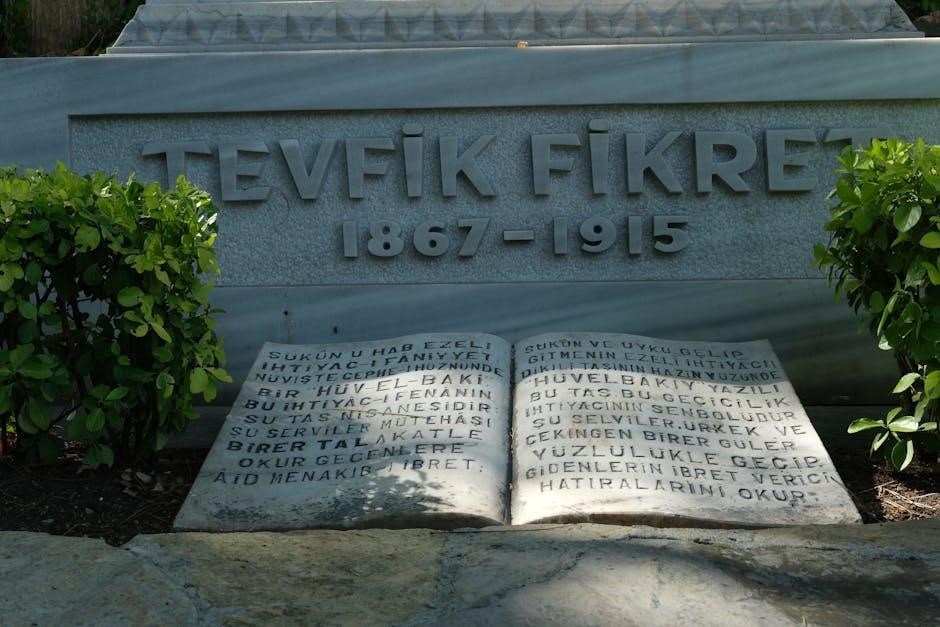HMH Into Literature Grade 8 is a comprehensive program designed to engage students in literary studies, fostering critical thinking, effective communication, and a deep appreciation for diverse texts, preparing them for high school success.
1.1 Overview of the Curriculum
The HMH Into Literature Grade 8 curriculum is a comprehensive, standards-based program designed to foster a deep understanding of literary and informational texts. It is structured into thematic units, such as Gadgets and Glitches, Ethical Dilemmas and Moral Choices, and Identity and Belonging, which encourage critical thinking and analysis. The program integrates grammar, vocabulary, and writing skills, with a focus on preparing students for high school and beyond. Digital resources, including an interactive PDF, enhance engagement and accessibility, while support materials for teachers ensure effective implementation. The curriculum emphasizes real-world applications, promoting confidence and a lifelong love for reading and writing.
1.2 Importance of Literary Studies in Grade 8
Literary studies in Grade 8 are essential for developing critical thinking, analytical skills, and effective communication. Through exploring diverse texts, students gain insights into different perspectives, cultures, and ethical dilemmas, fostering empathy and understanding. Literature also enhances vocabulary and writing abilities, preparing students for high school and future academic challenges. By engaging with complex themes, students develop a deeper appreciation for language and storytelling, which cultivates a lifelong love for reading and learning. These skills not only benefit academic success but also empower students to navigate real-world situations with confidence and creativity, making literary studies a cornerstone of eighth-grade education.
1.3 Key Features of the Into Literature Program
The Into Literature program offers a comprehensive approach to literary education, featuring interactive activities, technology integration, and robust support materials. It includes a digital student edition with offline access, enhancing flexibility for learners. The curriculum is structured around engaging units like “Gadgets and Glitches” and “Identity and Belonging,” fostering critical thinking and vocabulary growth. Additionally, the program provides grammar practice workbooks and formative assessments to track student progress. These features collectively create a dynamic and supportive learning environment, ensuring students build essential skills for academic success and a lifelong appreciation for literature.
Structure of the Into Literature Grade 8 PDF
The Grade 8 PDF is organized into interactive units, featuring digital tools, engaging activities, and clear navigation, ensuring a seamless learning experience for students.
2.1 Organization of the Digital Edition
The digital edition of Into Literature Grade 8 is thoughtfully organized into interactive units, each focusing on specific themes and skills. The flipbook format allows easy navigation, with a table of contents, thumbnails, and a search function for quick access to lessons. Units like “Gadgets and Glitches” and “Ethical Dilemmas” are structured to engage students with relevant topics. The PDF includes embedded interactive elements, such as videos and activities, to enhance learning. A zoom feature and fullscreen mode ensure readability and immersion. Offline access is also available, enabling students to study anywhere. This digital structure supports a seamless and engaging learning experience, aligning with the curriculum’s goals.
2.2 Navigating the Interactive PDF
Navigating the Into Literature Grade 8 interactive PDF is straightforward and intuitive. The digital edition features a user-friendly interface with a table of contents, thumbnails, and a search function for quick access to specific sections. Students can easily zoom in and out for readability and switch to fullscreen mode for an immersive experience. Interactive elements, such as videos and activities, are embedded directly within the PDF, enhancing engagement. Additionally, the PDF supports collaboration tools, allowing students to chat with teachers and peers. Offline access is also available, enabling learning on-the-go, with the ability to sync progress when reconnected. This seamless navigation ensures a productive and engaging learning journey.
2.3 Key Components of the Student Edition
The Into Literature Grade 8 Student Edition is a comprehensive resource designed to enhance learning. It features a digital anthology with engaging texts, including novels, poems, and nonfiction, accompanied by critical thinking questions. Interactive elements such as videos, audio clips, and hyperlinks enrich the content. The PDF includes grammar practice workbooks and vocabulary-building exercises to reinforce skills. Additionally, there are collaboration tools for peer and teacher interaction. The edition also provides access to support materials, such as lesson plans and assessments, ensuring a well-rounded educational experience. These components work together to foster deep understanding, creativity, and academic growth, making the Student Edition a valuable tool for Grade 8 students.

Core Skills Developed in Grade 8 Literature
Grade 8 Literature focuses on refining critical thinking, enhancing communication skills, and expanding vocabulary through engaging texts and interactive activities.
3.1 Critical Thinking and Analysis
Into Literature Grade 8 fosters critical thinking through engaging texts and activities that encourage students to analyze themes, characters, and plot structures. The program emphasizes close reading, evidence-based discussions, and the ability to interpret complex narratives. Students learn to identify literary devices, evaluate author intent, and connect themes to real-world issues. Interactive elements like Stream to Start videos and Essential Questions prompt deeper exploration of topics. By developing these analytical skills, students refine their ability to think independently and make informed judgments, preparing them for advanced academic challenges.
3.2 Effective Communication Strategies
Into Literature Grade 8 emphasizes the development of effective communication skills through engaging activities and collaborative tasks. Students learn to articulate their ideas clearly, both verbally and in writing, by participating in discussions, presentations, and reflective writing exercises. The program integrates interactive elements, such as Stream to Start videos and collaborative projects, to foster active listening and the ability to express opinions persuasively. By analyzing texts and synthesizing information, students refine their communication strategies, enabling them to convey complex ideas with confidence and clarity. These skills are essential for academic success and lifelong learning, preparing students to engage effectively in various social and professional contexts.
3.3 Vocabulary Building Techniques
Into Literature Grade 8 employs dynamic strategies to expand students’ vocabulary, fostering a deeper understanding of complex texts. The program introduces critical vocabulary through context clues, synonym and antonym analysis, and interactive activities. Students engage with word meanings through discussions, writing exercises, and multimedia resources, enhancing retention and application. The curriculum also encourages students to explore word origins and connotations, enriching their linguistic knowledge. These techniques not only improve comprehension but also empower students to express themselves more effectively in both written and verbal communication, preparing them for advanced academic challenges in high school and beyond.
Units and Lessons in Into Literature Grade 8
The program is divided into three thematic units: Gadgets and Glitches, Ethical Dilemmas and Moral Choices, and Identity and Belonging, each focusing on critical thinking and literary analysis.
4.1 Unit 1: Gadgets and Glitches
Unit 1, Gadgets and Glitches, explores the impact of technology on daily life, raising essential questions like, “Does technology improve or control our lives?” Through diverse texts, students analyze how gadgets influence human behavior and societal norms. Critical vocabulary such as reintegrate and enhancement is introduced, with activities focusing on context clues and synonym-antonym analysis. This unit encourages students to think critically about the role of technology, fostering a deeper understanding of its benefits and drawbacks. Engaging stories and discussions help students develop analytical skills while exploring the ethical implications of technological advancements in a fun and interactive manner.
4.2 Unit 2: Ethical Dilemmas and Moral Choices
Unit 2 delves into Ethical Dilemmas and Moral Choices, encouraging students to explore complex situations where decisions impact individuals and society. Through diverse texts, students analyze moral conflicts, applying Aristotelian virtue theory to resolve ethical issues. This unit emphasizes critical thinking, empathy, and the importance of ethical reasoning in real-world scenarios. By examining characters’ choices and their consequences, students develop skills to evaluate moral implications and make informed decisions. Interactive discussions and reflective writing activities help students articulate their perspectives, fostering a deeper understanding of the role of ethics in shaping personal and collective responsibilities. This unit prepares students to navigate life’s challenges with integrity and thoughtfulness.

4.3 Unit 3: Identity and Belonging
Unit 3, Identity and Belonging, invites students to explore how literature reflects personal and cultural identity. Through diverse texts, students examine how individuals navigate their sense of self and find their place within communities. This unit encourages self-reflection and empathy as students analyze characters’ journeys of self-discovery and the challenges of belonging. By connecting their own experiences with the themes presented, students develop a deeper understanding of the complexities of identity. Interactive discussions and reflective writing activities help students articulate their insights, fostering a sense of connection and appreciation for diverse perspectives. This unit empowers students to better understand themselves and others in an increasingly interconnected world.
Teaching Methods and Resources
The program incorporates interactive activities, technology integration, and teacher support materials to engage students and enhance instruction, ensuring a dynamic and effective learning experience.
5.1 Interactive Activities for Engagement
Into Literature Grade 8 incorporates dynamic interactive activities to captivate students and deepen their understanding. Features like Collaborate allow students to work with peers and teachers via chat, fostering teamwork and feedback. Stream to Start videos spark curiosity before reading, while interactive PDF elements provide hands-on learning. These activities encourage critical thinking, creativity, and effective communication, making literature engaging and accessible. By integrating technology and visual aids, the program breaks down complex concepts, ensuring students stay motivated and engaged throughout their educational journey.
5;2 The Role of Technology in Learning
Technology plays a pivotal role in enhancing the learning experience within Into Literature Grade 8. The program offers a digital student edition with interactive elements, such as Stream to Start videos, which spark engagement before reading. Collaborative tools allow students to chat with peers and teachers, fostering teamwork and feedback. Offline access ensures learning continues uninterrupted, while syncing features enable seamless progress tracking. Interactive PDFs provide hands-on activities, making complex concepts more accessible. These digital resources cater to diverse learning styles, promoting personalized learning and academic success. Technology integrates seamlessly with traditional methods, creating a dynamic and inclusive educational environment for all students.

5.3 Support Materials for Teachers
The Into Literature Grade 8 program provides robust support materials for teachers, ensuring effective instruction and student success; Resources include a detailed lesson planning guide, scope and sequence documents, and access to digital tools. Teachers can utilize interactive activities and collaborative platforms to engage students. Additional materials, such as tests and anthology guides, are available to support curriculum delivery. Program consultants, including Kylene Beers and Robert Probst, offer expert guidance, enhancing teaching strategies. These resources empower educators to create a dynamic, inclusive classroom environment, fostering both academic excellence and a love for learning in their students;
Grammar and Writing in Grade 8 Literature
Grammar and writing skills are refined through structured lessons, focusing on syntax, prepositions, and vocabulary. The curriculum emphasizes clear expression and effective communication, enhancing academic writing proficiency.
6.1 Understanding Prepositions: Into vs. In To
Mastering the distinction between into and in to is crucial for clear writing. Into is a preposition indicating movement or direction, as in “She walked into the room.” It also shows interest, like “into classical music.” On the other hand, in to is used when in and to are separate, often in verb phrases, such as “in order to achieve.” Confusing these can lead to grammatical errors. For example, “She turned in to get her coat.” Understanding this difference enhances precision and avoids common mistakes, improving overall writing clarity and effectiveness in Grade 8 literature studies.
6.2 Enhancing Writing Skills Through Literature
The Into Literature Grade 8 program emphasizes the connection between reading and writing, encouraging students to analyze literary texts and apply their insights to improve their writing. Through structured writing workshops, students engage in peer reviews, reflective journaling, and creative writing exercises. The curriculum provides modeled examples of effective writing, along with guided practice in crafting coherent paragraphs and essays. Interactive tools, such as writing frames and rubrics, help students refine their voice, tone, and style. By immersing students in diverse texts, the program fosters critical thinking and inspires confident, expressive writers capable of articulating their ideas clearly and persuasively in various formats.
6.3 The Importance of Syntax and Structure
Syntax and structure are foundational elements in the Into Literature Grade 8 curriculum, enabling students to craft clear, coherent, and impactful sentences. By analyzing literary texts, students learn how authors use sentence composition to convey meaning and tone. The program emphasizes the role of grammar in effective communication, providing interactive exercises to practice modifying sentences and organizing ideas logically. Understanding syntax enhances both reading comprehension and writing proficiency, allowing students to express their thoughts with precision and confidence. This skill is reinforced through guided practice, ensuring students master the mechanics of language and apply them in creative and analytical writing tasks.
Assessment and Evaluation
Assessment in Into Literature Grade 8 involves formative and summative evaluations to track student progress, ensuring understanding and mastery of literary skills through diverse, engaging measurement tools.
7.1 Formative Assessments in the Curriculum
Formative assessments in the Into Literature Grade 8 curriculum are designed to monitor student progress and understanding throughout the learning process. These assessments include quizzes, class discussions, and writing assignments that help teachers identify areas where students may need additional support. The program incorporates digital tools, such as interactive activities and progress-tracking features, to provide immediate feedback and guide instruction. Formative assessments also encourage students to reflect on their learning, fostering a growth mindset and preparing them for summative evaluations. This approach ensures that instruction is tailored to meet the diverse needs of all learners, promoting academic success and confidence.

7.2 Summative Assessments and Their Purpose
Summative assessments in the Into Literature Grade 8 curriculum serve as evaluations at the end of instructional units or the course to measure student mastery of skills and concepts. These assessments include unit tests, projects, and final exams, providing a comprehensive understanding of student learning. They help identify whether students have met the learning objectives and are prepared for high school. Summative assessments also provide teachers with valuable data to refine instruction and address gaps in student understanding. By evaluating overall performance, these assessments ensure students are well-equipped with the skills needed for future academic success and lifelong learning.
7.3 Tools for Measuring Student Progress
The Into Literature Grade 8 program incorporates various tools to measure student progress effectively. These include quizzes, writing prompts, and projects embedded within the digital edition. Diagnostic tests at the beginning of each unit help identify baseline understanding, while formative assessments throughout the lessons monitor growth. Interactive activities and discussions provide opportunities for informal assessment, allowing teachers to gauge comprehension and critical thinking skills. The HMH platform also offers data-driven reports, enabling educators to track individual and class progress. These tools ensure that students are on track to meet learning objectives, fostering a culture of continuous improvement and preparedness for future academic challenges.
Benefits of Using Into Literature Grade 8
Into Literature Grade 8 prepares students for high school success by fostering critical thinking and communication skills. It encourages a lifelong love for reading and builds academic confidence through engaging, relevant content.
8.1 Preparing Students for High School
Into Literature Grade 8 bridges the gap between middle and high school by developing essential skills in critical thinking, analysis, and effective communication. The program introduces complex texts and analytical practices, mirroring high school expectations. Students engage with diverse literary works, fostering a deeper understanding of themes and genres. Interactive activities and digital tools enhance learning, preparing students for the academic rigor of high school. The curriculum emphasizes vocabulary growth and syntactical awareness, equipping learners with the confidence and skills needed for future success. This comprehensive approach ensures students are academically and technologically ready for the challenges of high school and beyond.
8.2 Fostering a Love for Reading and Writing
Into Literature Grade 8 ignites a passion for reading and writing by engaging students with diverse, meaningful texts and interactive activities. The program’s Stream to Start videos spark curiosity, encouraging students to explore themes and genres. Through discussions, creative writing exercises, and critical analysis, learners develop a deeper connection to literature. Digital tools and real-world applications make reading and writing relevant and enjoyable. By fostering this love, the program empowers students to express themselves confidently and find joy in literary exploration, setting the foundation for a lifelong appreciation of reading and writing.
8.3 Building Confidence in Academic Skills
Into Literature Grade 8 helps students build confidence in their academic skills through a structured approach to learning. The program scaffolds skills, starting with foundational concepts and gradually increasing complexity. Interactive activities, such as Stream to Start videos and collaborative projects, encourage active participation and engagement. By breaking down challenging tasks into manageable steps, students gain a sense of accomplishment and self-assurance. The program’s emphasis on critical thinking, analysis, and effective communication empowers learners to express their ideas clearly and confidently. This supportive environment fosters resilience and prepares students to tackle more advanced academic challenges with confidence.
The Role of Digital Resources
Digital resources in Into Literature Grade 8 enhance learning through interactive elements, accessible anytime, and offline capabilities, ensuring flexibility and engagement for modern students.
9.1 Accessing the Digital Student Edition
Accessing the Into Literature Grade 8 digital student edition is straightforward through platforms like VitalSource or the HMH website. Students and teachers can download the interactive PDF, ensuring flexibility and convenience. The digital edition is optimized for online and offline use, allowing learners to engage with content anywhere. Features like searchable text, bookmarks, and annotations enhance the learning experience. Schools can purchase access codes, while individual subscriptions are also available, making it accessible to all users. This digital format supports modern learning needs, providing an engaging and adaptable resource for literary exploration and skill development.

9.2 Offline Access and Syncing Features
The Into Literature Grade 8 digital edition offers seamless offline access, allowing students to study without internet connectivity. Once downloaded, the interactive PDF remains fully functional, ensuring uninterrupted learning. Syncing capabilities enable users to access their content across multiple devices, maintaining consistency and flexibility. Annotations and highlights made offline automatically sync when reconnected, preserving all work. This feature is particularly useful for remote learning or areas with limited internet access. The platform ensures that students can engage with the material anytime, promoting continuous learning and academic progress. Offline access and syncing are integral to the program’s adaptability, catering to diverse learning environments and preferences.

9.3 Interactive Elements for Enhanced Learning
The Into Literature Grade 8 interactive PDF is enriched with dynamic features that enhance student engagement and understanding. Stream to Start videos spark curiosity at the beginning of each unit, while audio narrations provide support for diverse learners. Interactive activities, such as self-assessment rubrics and collaborative tools, encourage active participation and peer-to-peer learning. The digital edition includes clickable thumbnails, zoom functionality, and a search tool for easy navigation. These elements create a immersive learning experience, fostering deeper connections with the material. By integrating technology, the program ensures that students can explore literature in a dynamic and interactive way, making learning both enjoyable and effective.
Into Literature Grade 8 effectively builds confidence, standards mastery, and prepares students for high school and beyond, offering an engaging and immersive learning experience through its interactive features.
10.1 Summary of Key Takeaways
Into Literature Grade 8 is a dynamic curriculum that fosters critical thinking, effective communication, and a love for reading and writing. It prepares students for high school by enhancing academic skills and confidence. The program integrates interactive digital resources, including a flip PDF version, to engage learners and cater to diverse learning styles. By exploring units like Gadgets and Glitches and Identity and Belonging, students develop essential skills in analysis and vocabulary building. The curriculum also emphasizes grammar and syntax, with a focus on prepositions like into vs. in to. Teachers are supported with comprehensive materials, while students benefit from formative and summative assessments to track progress. Overall, the program is designed to empower students academically and creatively, ensuring they are well-prepared for future challenges.
10.2 The Impact of Into Literature on Student Success
Into Literature Grade 8 significantly impacts student success by fostering a deeper understanding of literary concepts and developing essential skills. The program’s interactive and engaging approach enhances critical thinking, communication, and creativity, preparing students for high school and beyond. By exploring diverse texts and themes, students build confidence and a lifelong appreciation for literature. The curriculum’s structured lessons and digital resources, such as the flip PDF, ensure accessibility and cater to various learning styles. Additionally, the focus on grammar, syntax, and vocabulary helps students refine their writing and analytical abilities. Overall, Into Literature equips students with the tools and confidence needed to excel academically and personally.
